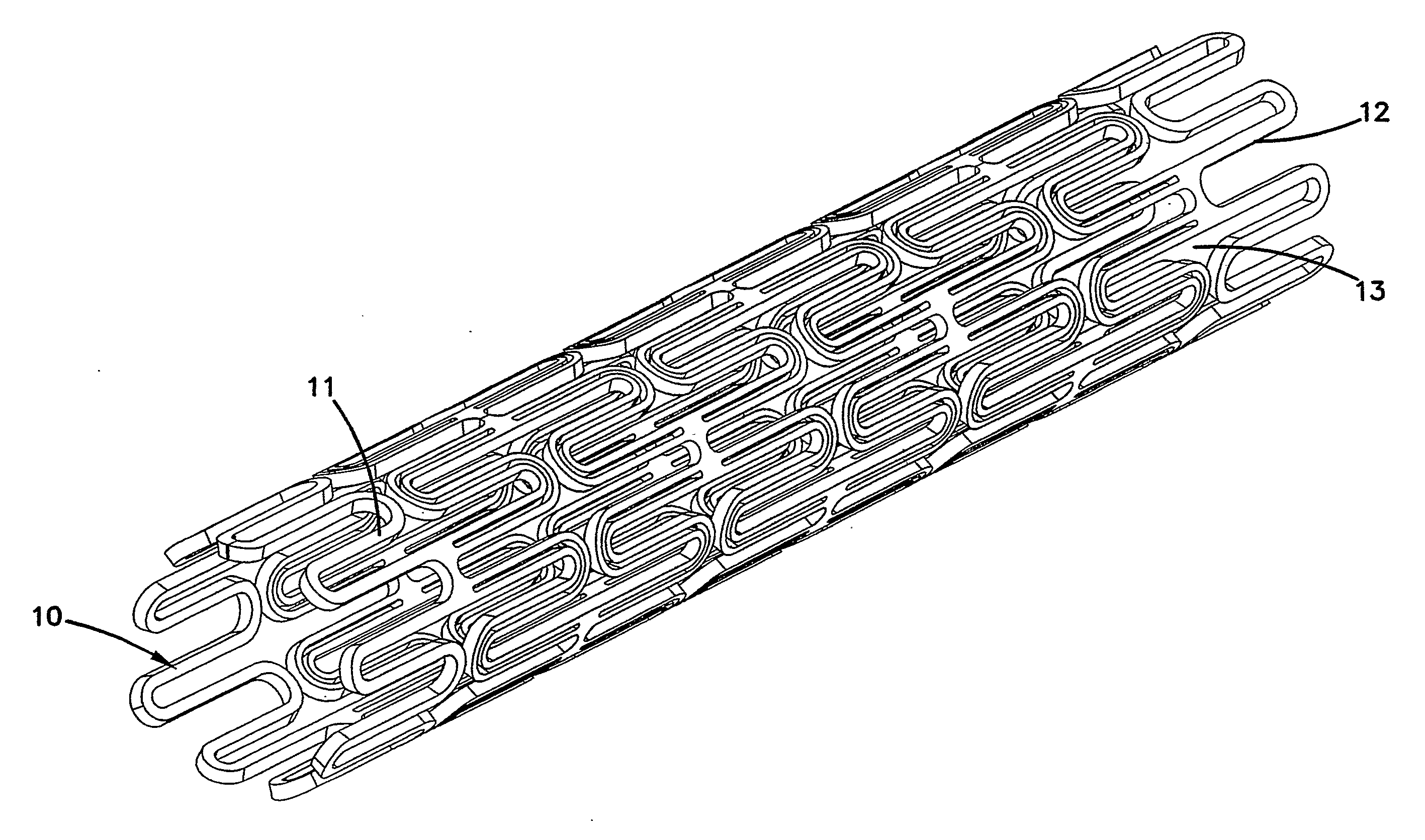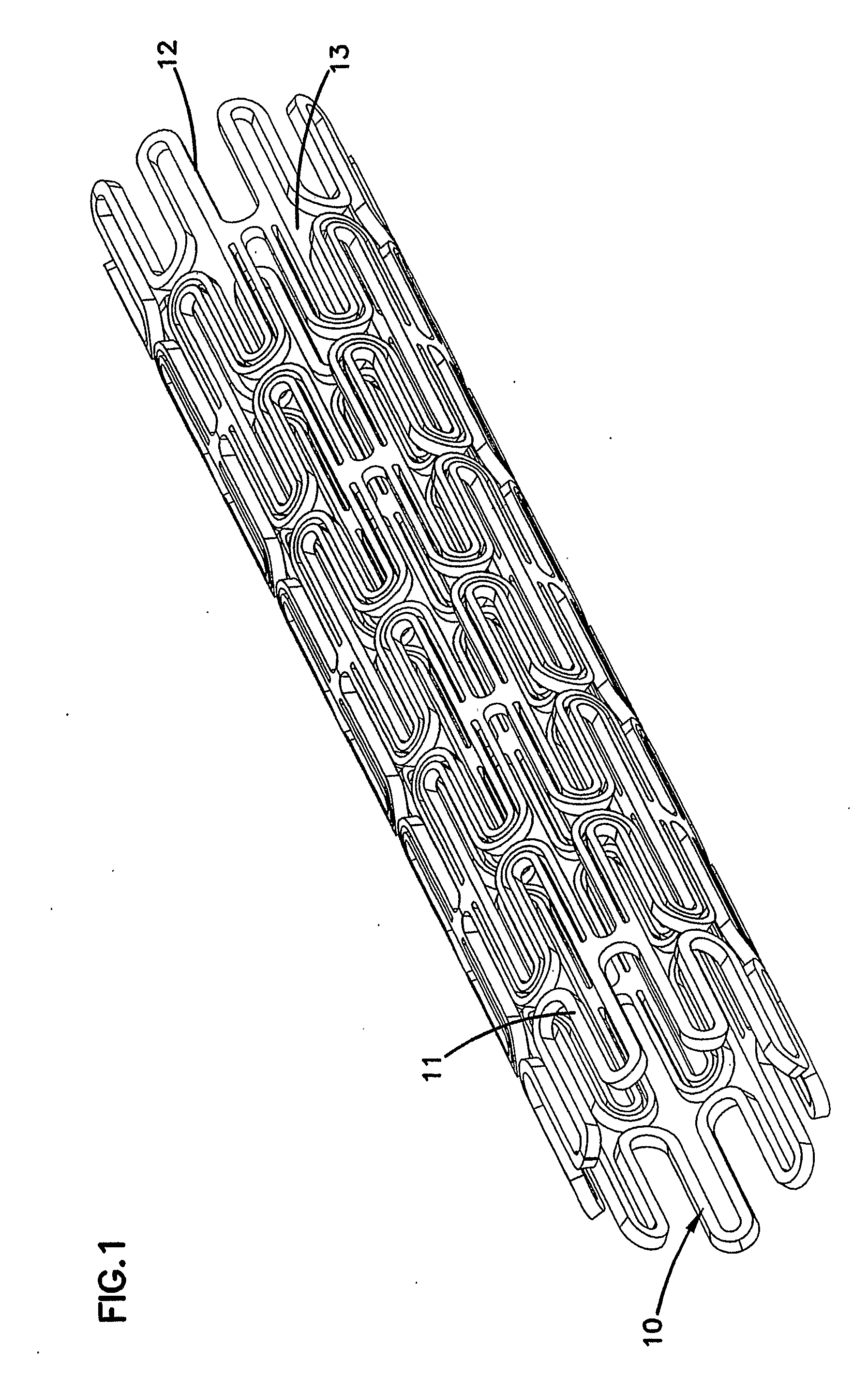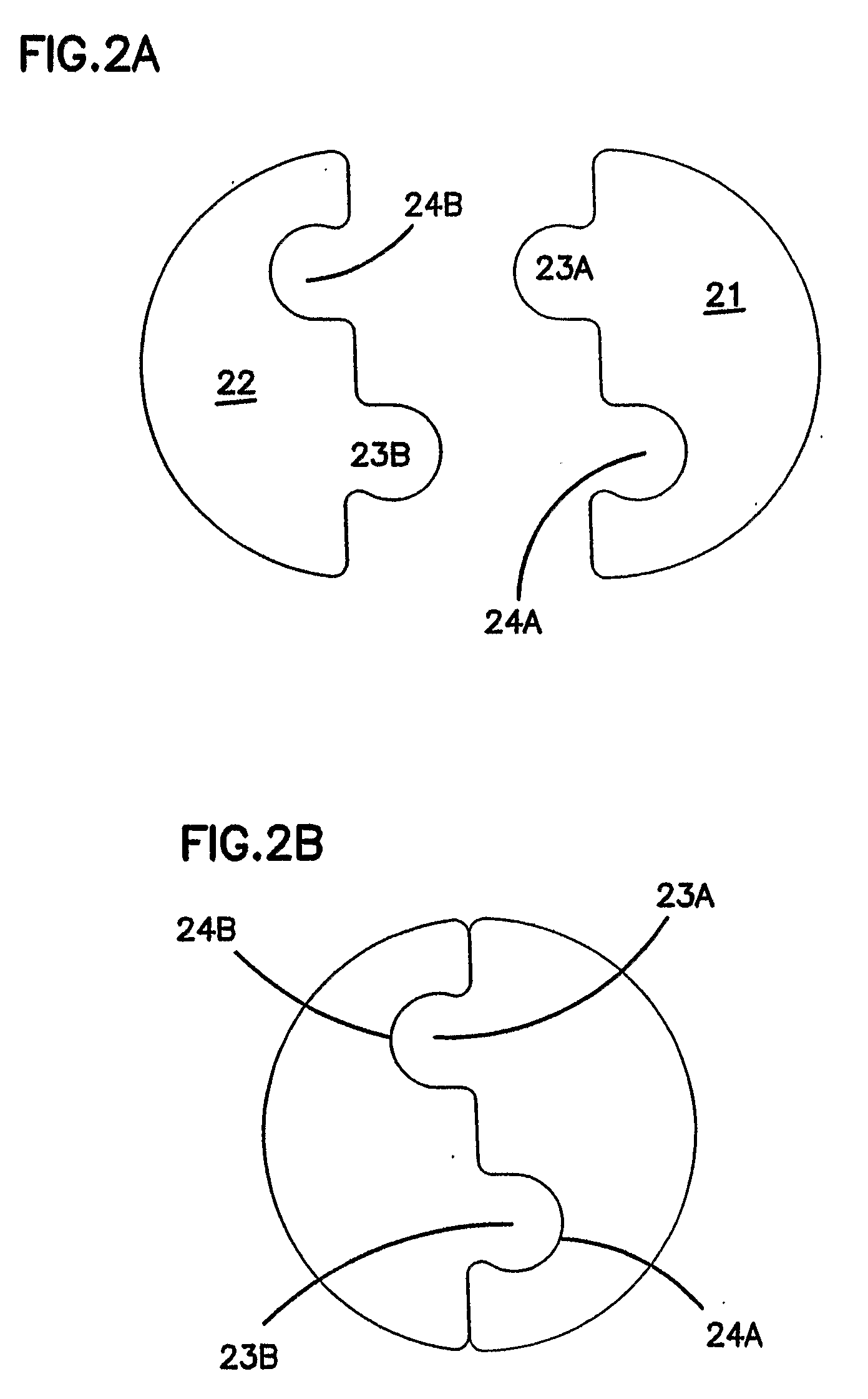[0031]
Metal particulate that can be used in the composites of the invention include
tungsten,
uranium,
osmium,
iridium,
platinum,
rhenium, gold,
neptunium,
plutonium and
tantalum and can have a secondary metal such as iron,
copper,
nickel,
cobalt,
tin,
bismuth and
zinc. While an
advantage is that non-toxic or non-radioactive materials can be used as a substitute for lead and
depleted uranium where needed, lead and
uranium can be used when the materials have no adverse
impact on the intended use. Another
advantage of the invention is the ability to create bimetallic or higher composites that use two or more metal materials that cannot naturally form an
alloy. A variety of properties can be tailored through a careful selection of metal or a combination of metals and polymer and the
toxicity or radioactivity of the materials can be designed into the materials as desired. These materials are not used as large metal particles, but are typically used as small metal particles, commonly called metal
particulates. Such
particulates have a relatively low
aspect ratio and are typically less than about 1:3
aspect ratio. An
aspect ratio is typically defined as the ratio of the greatest dimension of the particulate divided by the smallest dimension of the particulate. Generally, spherical
particulates are preferred, however, sufficient packing densities can be obtained from relatively uniform particles in a dense structure.
[0032]The composite materials of the invention combine a metal particulate at a maximum tap density leaving an excluded volume and a polymer material substantially occupying the excluded volume, but no more, to obtain the highest possible density from the composite composition.
[0033]A variety of high-density metals can be used.
Tungsten (W) has an atomic weight of 183.84; an
atomic number of 74 and is in Group VIB(6). Naturally occurring isotopes are 180 (0.135%); 182 (26.4%); 183 (14.4%); 184 (30.6%); 186 (28.4%) and artificial radioactive isotopes are 173-179; 181; 185; 187-189.
Tungsten was discovered by C. W. Scheele in 1781 and isolated in 1783 by J. J. and F. de Elhuyar. One of the rarer metals, it comprises about 1.5 ppm of the earth's crust. Chief ores are
Wolframite [(Fe,Mn)WO4] and
Scheelite (CaWO4) found chiefly in China, Malaya, Mexico, Alaska, South America and Portugal.
Scheelite ores mined in the U.S. carry from 0.4-1.0% WO3. Description of isolation processes are found in K. C. Li, C. Y. Wang,
Tungsten, A.C.S. Monograph Series no. 94 (Reinhold, New York, 3rd ed., 1955) pp 113-269; G. D. Rieck, Tungsten and Its Compounds (Pergamon Press, New York, 1967) 154 pp. Reviews: Parish, Advan. Inorg. Chem. Radiochem. 9, 315-354 (1966); Rollinson, “
Chromium,
Molybdenum and Tungsten” in Comprehensive
Inorganic Chemistry Vol. 3, J. C. Bailar, Jr. et al., Eds. (Pergamon Press, Oxford, 1973) pp 623-624, 742-769. Tungsten is a steel-gray to
tin-
white metal having in
crystal form, a body centered cubic structure. Its density is d420 18.7-19.3; Its
hardness is 6.5-7.5,
melting point is 3410° C.,
boiling point is 5900° C.,
specific heat (20° C.) is 0.032 cal / g / ° C., heat of fusion is 44 cal / g, heat of
vaporization is 1150 cal / g and electrical resistivity (20° C.) is 5.5 μohm-cm. Tungsten is stable in dry air at ordinary temperatures, but forms the
trioxide at red heat, is not attacked by water, but is oxidized to the dioxide by steam. Particulate
tungsten can be pyrophoric under the right conditions and is slowly soluble in fused
potassium hydroxide or
sodium carbonate in presence of air; is soluble in a fused mixture of NaOH and
nitrate. Tungsten is attacked by
fluorine at
room temperature; by
chlorine at 250-300° C. giving the hexachloride in absence of air, and the
trioxide and oxychloride in the presence of air. In summary the
melting point is 3410° C., the
boiling point is 5900° C. and the density is d42 18.7-19.3.
[0034]
Uranium (U) has an atomic weight of 238.0289 (characteristic naturally occurring isotopic mixture); an
atomic number of 92 with no stable nuclides. Naturally occurring isotopes are 238 (99.275%); 235 (0.718%); 234 (0.005%); artificial radioactive isotopes are 226-233; 236; 237; 239; 240.
Uranium comprises about 2.1 ppm of the earth's crust. Main
uranium ores of commercial interest are carnotite, pitchblende, tobemite and autunite. Commercially important mines are located in Elliot Lake-Blind River area in Canada, Rand gold fields in South Africa, Colorado and Utah in the United States, in Australia and in France. The discovery from pitchblende is found in M. H. Klaproth, Chem. Ann. II, 387 (1789). Preparation of the metal is found in E. Peligot, C.R. Acad. Sci. 12, 735 (1841) and Idem, Ann. Chim. Phys. 5, 5 (1842).
Flow sheet and details of preparation of pure uranium metal are found in Chem. Eng. 62, No. 10, 113 (1955); Spedding et al., U.S. Pat. No. 2,852,364 (1958 to U.S.A.E.C.). Reviews: Mellor's Vol. XII, 1-138 (1932); C. D. Harrington, A. R. Ruehle,
Uranium Production Technology (Van Nostrand, Princeton, 1959); E. H. P. Cordfunke, The
Chemistry of Uranium (Elsevier, New York, 1969) 2550 pp; several authors in Handb. Exp. Pharmakol, 36, 3-306 (1973); “The Actinides,” in Comprehensive
Inorganic Chemistry Vol. 5, J. C. Bailar, Jr., et al., Eds. (Pergamon Press, Oxford, 1973) passim; F. Weigel in Kirk-Othmer
Encyclopedia of
Chemical Technology Vol. 23 (Wiley-Interscience, New York, 3rd ed., 1983) pp 502-547; idem in The
Chemistry of the
Actinide Elements Vol. 1, J. J. Katz et al., Eds. (Chapman and Hall, New York 1986) pp 169-442; J. C. Spirlet et al., Adv. Inorg. Chem. 31, 1-40 (1987). A review of
toxicology and health effects is found in Toxicological Profile for Uranium (PB91-180471, 1990) 205 pp. Uranium is a silver-white, lustrous, radioactive metal that is both malleable and ductile, and tarnishes rapidly in air forming a layer of dark-
colored oxide. Heat of
vaporization is 446.7 kJ / mol; heat of fusion is 19.7 kJ / mol; heat of sublimation is 487.9 kJ / mol. Particulate uranium metal and some uranium compounds may ignite spontaneously in air or
oxygen and are rapidly soluble in aqueous HCl. Non-oxidizing acids such as sulfuric, phosphoric and hydrofluoric react only very slowly with uranium;
nitric acid dissolves uranium at a moderate rate; and
dissolution of particulate Uranium in
nitric acid may approach explosive violence. Uranium metal is
inert to alkalis. In summary, the
melting point is 1132.8±0.8° and density is 19.07; d 18.11; d 18.06.
[0035]
Osmium (O) has an atomic weight of 190.23; an
atomic number of 76 and is in Group VIII(8). Naturally occurring isotopes are 184 (0.02%); 186 (1.6%); 187 (1.6%); 188 (13.3%); 189 (16.1%); 190 (26.4%); 192 (41.0%). Artificial radioactive isotopes are 181-183; 185; 191; 193-195.
Osmium comprises about 0.001 ppm of the earth's crust and is found in the mineral osmiridium and in all
platinum ores. Tennant discovered
osmium in 1804. Preparation is found in Berzelius et al., cited by Mellor, A Comprehensive Treatise on Inorganic and Theoretical
Chemistry 15, 6887 (1936). Reviews: Gilchrist, Chem. Rev. 32, 277-372 (1943); Beamish et al., in Rare Metals Handbook, C. A. Hampel, Ed. (Reinhold New York, 1956) pp 291-328; Griffith, Quart. Rev. 19, 254-273 (1965); idem, The Chemistry of the Rarer
Platinum Metals (John Wiley, New York, 1967) pp 1-125; Livingstone in Comprehensive
Inorganic Chemistry, Vol. 3, J. C. Bailar, Jr. et al. Eds. (Pergamon Press, Oxford, 1973) pp 1163-1189, 1209-1233.
Osmium is a bluish-white, lustrous metal with a close-packed hexagonal structure. With a density of d420 22.61, it has been long believed to be the densest element. X-
ray data has shown it to be slightly less dense than
iridium with a melting point of about 2700° C.,
boiling point of about 5500° C., a density of d420 22.61,
specific heat (0° C.) 0.0309 cal / g / ° C. and
hardness 7.0 on Mohs' scale. Osmium is stable in
cold air and, in the particulate, is slowly oxidized by air even at ordinary temperature to form tetroxide. Osmium is attacked by
fluorine above 100° C., by dry
chlorine on heating, but not attacked by
bromine or
iodine. Osmium is attacked by
aqua regia, by oxidizing acids over a long period of time, but barely affected by HCl, H2SO4. Osmium burns in vapor of
phosphorus to form a
phosphide, in vapor of
sulfur to form a
sulfide. Osmium is also attacked by molten alkali hydrosulfates, by
potassium hydroxide and oxidizing agents. Particulate
osmium absorbs a considerable amount of
hydrogen. In summary, osmium has a melting point of about 2700° C., a boiling point of about 5500° C. and a density of d420 22.61.
[0036]
Iridium (Ir) has an atomic weight of 192.217 and an atomic number of 77. Naturally occurring isotopes are 191 (38.5%); 193 (61.5%) and artificial radioactive isotopes are 182-191; 194-198. It comprises about 0.001 ppm of the earth's crust.
Iridium was discovered by Tennant. It occurs in nature in the metallic state, usually as a natural
alloy with osmium (osmiridium) and found in small quantities alloyed with native
platinum (platinum mineral) or with native gold.
Recovery and purification from osmiridium are found in Deville, Debray, Ann. Chim. Phys. 61, 84 (1861); from the platinum mineral: Wichers, J. Res. Nat. Bur. Stand. 10, 819 (1933). Reviews of preparation, properties and
chemistry of
iridium and other platinum metals: Gilchrist, Chem. Rev. 32, 277-372 (1943); W. P. Griffith, the Chemistry of the Rare
Platinum Metals (John Wiley, New York, 1967) pp 1-41, 227-312; Livingstone in Comprehensive Inorganic Chemistry Vol. 3, J. C. Bailar Jr. et al., Eds. (Pergamon Press, Oxford, 1973) pp 1163-1189, 1254-1274.
Iridium is a silver-white, very
hard metal; face-centered cubic lattice with a melting point of 2450° C., boiling point of about 4500° C. with a density of d420 22.65,
specific heat of 0.0307 cal / g / ° C., Mohs'
hardness of 6.5 and has the highest
specific gravity of all elements. Acids including
aqua regia do not
attack pure iridium and only the metal is slightly attacked by fused (non-oxidizing) alkalis. It is superficially oxidized on heating in the air, is attacked by
fluorine and
chlorine at a red heat, attacked by
potassium sulfate or by a mixture of
potassium hydroxide and
nitrate on fusion, attacked by lead,
zinc or
tin.
Particulate metal is oxidized by air or
oxygen at a red heat to the dioxide, IrO2, but on further heating the dioxide dissociates into its constituents. In summary, iridium has a melting point of 2450° C., a boiling point of about 4500° C. and a density of d42 22.65.
 Login to View More
Login to View More 


